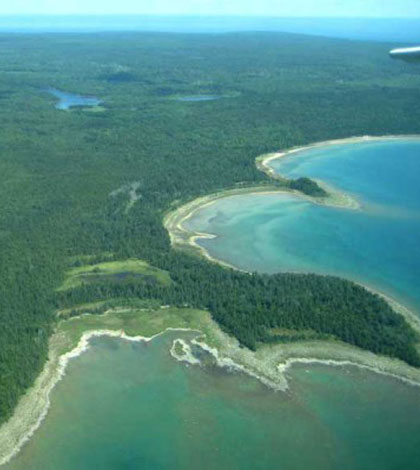GEORGIAN BAY—Restore Our Water International (ROWI), which is in direct communication with the United States Army Corps of Engineers (USACE) is hopeful Canada will put the money on the table in order to press the US Congress to do the same so that compensation sills or speed bumps will be constructed in the St. Clair River to help alleviate low water levels in Lake Huron and the Great Lakes.
“We held a series of meetings earlier in July, at the south end of Georgian Bay,” said Mary Muter, vice-chair of ROWI, last week. “ROWI is in direct communication with the USACE, which has been given authorization for any options being considered for work on Lake Huron and the Great Lakes. Now we are looking for funding to get this work done.”
Ms. Muter noted an outstanding 1962 Canada/US agreement to place compensation sills or speed bumps in the St. Clair River. The agreement was a condition of the dredging of the river for navigation in the 1930s and again in 1962, when USACE received authorization to install the sills. It turns out that authorization was never withdrawn and could now finally move ahead. The Corps is now reviewing its St. Clair River flow data and depth profiles with a view to moving forward with an environmental impact study, cost benefit analysis and ultimately, placing sills in the river to slow the outflow. More sills could follow, along with gates and other measures to control the massive erosion in the river.
“We need a long term solution to this ongoing loss of water from these two important lakes,” said Roger Gauthier, a retired US Army Corps of Engineers senior hydrologist who is chair of ROWI and a program director of the Great Lakes Commission, in the summer 2013 edition of On the Bay Magazine. “It is time our governments acted to finally complete the terms of the outstanding bi-national agreement to install compensation structures in the St. Clair River to offset increased outflows caused by navigation dredging and sand mining in the river.”
“To get that funding needed our foreign affairs department needs the US government to agree to match the funding for the measures on the St. Clair,” said Ms. Muter. “If Canada puts their money on the table, it might be a little easier to get the US to do the same.”
ROWI held its meetings in July in Blue Mountains, Owen Sound, Midland, Tiny Township, Tay Township, Owen Sound and Collingwood early in July. ROWI was holding the public meetings to update the community about what can be done about the unprecedented low water levels. Among the guest speakers were Ms. Muter, Dr. Pat-Chow Fraser, professor at McMaster University and ecologist who spoke on the ecological impact of 14 years of low water levels, Mayor Sandra Cooper of Collingwood and a member of Great Lakes and St. Lawrence Cities Initiative in regards to the low levels in Georgian Bay and the progress so far. The keynote speaker was Mr. Gauthier, chair of ROWI, and a recently retired senior hydrologist who spent 30 years with the USACE.
“That’s right, we want our two governments to provide funding, and for the US to put this funding in their federal 205 budget,” said Ms. Muter. She said ROWI will be pressing for the Canadian government to provide funding for the necessary work in its 2014 budget.
In a letter on its website to both governments, ROWI states in part: ”a cost effective, well-engineered viable solution is available, called submerged sills or speed bumps. The proposal is for sills to be installed along the St. Clair River to reduce the water flow, without impairing shipping or fish habitat. The cost $100—$200 million over several years.”
“Citizens around the lakes are requesting you to work with the Canadian and United States governments to implement the installation of submerged sills in the St. Clair River to restore water levels gradually and responsible.”
“This serious problem warrants your active attention. Please use your considerable influence to get our water levels restored.”
Recently the IJC recommended that the governments of Canada and the United States investigate structural options to restore water levels in Lake Michigan-Huron by 13-25 centimetres (about five to 10 inches) including a comprehensive cost-benefit analysis and a detailed environmental impact study. Specifically, the commission encouraged governments to focus on options that would not exacerbate future high water levels but that would provide relief during periods of low water.
“Although future water levels are uncertain, we cannot ignore the damage from record low water levels,” said Joe Comuzzi, Canadian Chair of the commission on the ROWI website. “From Georgian Bay to Door Country, from shoreline property owners to the shipping industry, we heard calls for action and we urge governments to act in response to our recommendations.”
The letter adds, “the problem will not be solved until several US government departments and the White House agree that the crisis is real and that the St. Clair River compensation terms of the outstanding Canada-USA agreement now need to be met.”




